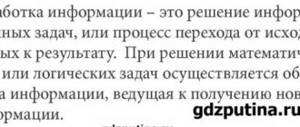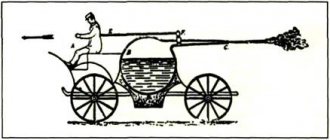Not a day without news!
A variety of sources of information - newspapers, radio, telegraph, television, the Internet, correspondence and conversations with other people - feed a person’s natural curiosity about what is happening outside the walls of his home. Sometimes this saves life and health (a warning from the weather center about an approaching natural disaster, calls from a charitable foundation to help a sick person). Negative information can encourage unseemly actions, vindictiveness, aggression (rumors spread by ill-wishers about family and affairs).
A person strives for new knowledge for its practical use in work activities.
For example: a builder wants to know about the features of a tool that is new to him in order to be able to use it; the doctor carefully studies the instructions for use of the drug; The teacher regularly reads professional literature. The very process of receiving and transmitting information can become entertainment: direct communication with friends during meetings or by phone, on social networks.
Artificial sources
Until the end of the 19th century, the only artificial source of light was fire, in all its interpretations. Later, the rapid development of electric light sources began actively. Over almost 130 years of their existence, fire was almost completely replaced - kerosene lamps and candles appeared. They are still used when there is an accident at the station, when the lighting suddenly goes out, for a romantic evening, to create an appropriate atmosphere. On camping trips, when the flashlights run out, they use a kerosene lamp. For more extensive lighting, you can light a fire.
Is a fire an artificial or natural source of light? It should be sorted out. The flame of burning dry twigs, as well as the flame of a candle, gas burner, and so on, are artificial sources. I would like to note one feature. Artificial light sources can be controlled by people.
Let's think like this: in principle, the fire burns on its own, giving off heat as well. You can warm up next to it, and see friends in the dark sitting opposite and singing with a guitar. It seems like a fire is a natural source of light. He gives his unreflected light, like the Moon. But then the fire begins to go out, and it becomes necessary to add more wood. The more wood, the larger the flame. This means it can be controlled. Moreover, the fire was originally created by the tourists themselves. And artificial sources are those created by man. This suggests a conclusion: a fire is still an artificial source of light.
Technical devices of the most varied structures are also artificial. These are incandescent lamps, spotlights, electric lamps, etc. There are bodies that cannot emit on their own, but emit reflected light, for example, the Moon.
Let's take a closer look at which light sources are natural.
Information - what is it?
Its consumer lives in uncertainty regarding the cognitive material that interests him until he receives the necessary information - information. Thanks to her, ideas about the environment become clear and concrete. The founder of information theory, K. Shannon (USA), believed that information is the elimination of uncertainty.
This term has many explanations in various fields of knowledge, but there is no single interpretation of it. In general, the information is:
- information about the environment;
- something with which a person’s assumptions about something are replenished;
- it is a derivative product of our body obtained through the use of media;
- These are facts of the external world that are significant for the individual.
External information is perceived not only by humans and other organisms, but also by special equipment created by them.
Information Properties
Any object has its own qualities, which may or may not be changed by outside influence. A person wants to receive information that has the following properties:
- value and usefulness - for solving the problems facing it;
- objectivity and reliability - otherwise the information received will turn out to be useless, misinformation, and will lead to the wrong choice of means, place, time of action;
- accuracy, completeness - guarantee the use of a sufficient amount of effort and resources;
- relevance - timely receipt of information makes it useful and valuable.
In addition, the information obtained must be concise and understandable to ensure its correct use.
Distortion of the properties of information, or even one of them, may be intentional (with the aim of misleading the recipient).
Or involuntary - due to the imperfection of the means of transmission, due to the subjective vision and assessment of problems and their details.
Obtaining information about an object of interest from additional sources of information, the emergence of more advanced ways of studying it leads to obsolescence, partial or complete updating of knowledge.
Where to look for the truth? On the reliability of information sources
The author’s subjective assessment of the degree of reliability of information sources (information noise) based on forty years of scientific experience is as follows.
Textbook, encyclopedia, database, explanatory dictionary. Here is the most proven, established, carefully edited knowledge. Information noise in relative units is equal to 1. This is outdated information and “blunders”. For example, in the French encyclopedia Larousse, in the 1903 edition of which there was an article: “Ivan the Fourth, Tsar of All Rus', nicknamed Vasilyevich for his cruelty.” Everyone made fun of the French, however, even in domestic encyclopedias there were some oddities. These are ideological shifters. A separate article in the second edition of the Great Soviet Encyclopedia is devoted to such “pseudoscience” as genetics, but it was written by academician T.D. Lysenko. With all the ensuing consequences, including imprisonment and execution. “The defeat of Mendelism-Morganism at the August session of the All-Union Academy of Agricultural Sciences named after V.I. Lenin aroused the anger of reactionaries from politics and science throughout the world.”
Original article, review, special monograph. Main sources of scientific information with cross-reference system. Information noise - 3. These are experimental errors that are not visible to editors and reviewers, new untested concepts.
Popular science, educational magazine or book. The purpose of this kind of publication is to interest the ordinary reader who does not speak special scientific languages, to encourage him to independently search for knowledge. One of the reasons why I write to ShkolaZhizni.ru lies precisely in this. In Russia, the most authoritative magazines are “Nature”, “Science and Life”, “Knowledge is Power”, “Chemistry and Life”. Any mature scientist will tell you that he came to science not without the influence of such sources. Information noise - 10, due to the loss of rigor as a result of the popularization of knowledge.
Mass media (media). Information noise - 30. Television, newspapers, radio are just an effective way of forming public opinion. The election of V.V. Putin as President of Russia in 2000, a man at that time without a public political face, is a phenomenon of the influence of the media on Russians, impossible in a country with developed democratic traditions. A famous joke: “Why did the Ostankino Tower burn down? “Out of shame for the journalistic lies.” Conscious lies - PR, black PR. A lie due to the lack of education of journalists. In 2000, I read a note in AiF-Khabarovsk “To the sea with a dosimeter” - they meant the Sea of Japan. And he was horrified. Six paragraphs and six errors. He suggested writing a refutation. Editor's response: If you don't scare them, they won't read it. I had to write a separate article, “Man in a Radioactive World.”
In 1990, I published a note “Ecology of the Word”, in which I wrote: “Ecology is the science of the relationships of animal organisms and the communities they form between themselves and the environment. The printed word is at least bifunctional. On the one hand, this is an element of the environment, since information flows envelop a person like air. Many people get sick due to lack of information. But even those who try to breathe less often (that is, not read), still encounter the word in the form of rumors, retellings, newspaper reviews on television and radio. On the other hand, the word is an element of language and culture. Pollution of the information space is as unacceptable as that of water, air and daily bread.”
Internet. Information noise - 3−100, depending on the site. For example, Wikipedia is a very uneven electronic publication, mainly concerned with preventing plagiarism. There are brilliant, well-illustrated articles, and there are also outright errors, especially in natural science articles, that have to be corrected.
Advertising. Information noise - 1000. This is not a source of information at all, since the goal is the formation of needs, the market, and not the transfer of knowledge.
Let me emphasize once again that the numbers are the author’s subjective assessment, but the general trend is outlined.
Tags: modernity, knowledge, media, information space, truth, information
Types of information
In computer science, methods of storing and encrypting, transmitting and receiving information determine its type:
- Graphic - information in the form of images printed on surfaces, objects: drawings, diagrams, graphs, photographs, tattoos. The most ancient of all types of information.
- Text - encoding speech using special characters - letters. The text can be printed, handwritten, applied with a tool to any surface (Russian birch bark letters, Egyptian cuneiform on stone).
- Sound - has existed since 1877, when Thomas Edison (USA) invented the phonograph - a device that records and reproduces sound: speech, music.
- Numerical, digital - used to convey information about the quantitative characteristics of objects (width, height, volume, area, quantity) using symbols in the form of numbers.
- Video information - appeared with the invention of cinema - “living pictures” - by the Lumière brothers (France, 1895).
Scientific classification of types of information:
- primary, or objective information - states of objects that, through contact, are transferred to other objects and stored in their composition;
- secondary, or subjective information - passed through human consciousness through verbal or visual images, sensations and imprinted on a medium - paper, stone, canvas, etc.
Its specific types are associated with the sensory method of reception: olfactory, gustatory, tactile, visual, auditory. People also use mixed types of information, for example, video writing, film.
Sources and consumers of information
Modern people receive new knowledge and information through various channels (Internet, television, radio, periodicals). The main sources of information, that is, its suppliers, are people and events. It comes from government and other institutions, from scientific, amateur communities, from individuals, and can be official or unofficial, open (intended for everyone) or closed (for a small circle of specialists), personal.
Information consumers:
- society - mass information is addressed to it, the essence of which is clear to most of its members (reports of events, resolutions, decrees);
- a narrow group of like-minded specialists who can understand the specific information (sometimes secret) necessary for their activities (for example, scientists, intelligence);
- individual individuals - the data is private, interesting and useful for one person.
The sources of information used are varied and can be animate or inanimate (natural processes, literature).
§ 3. ARTIFICIAL AND NATURAL SOURCES OF INFORMATION. - presentation
§ 3. ARTIFICIAL AND NATURAL SOURCES OF INFORMATION
Here is a sparrow bathing in a puddle after the rain and chirping joyfully.
By watching a bird, we receive both visual and audio information. The puddle and the sparrow are natural, that is, natural sources of information for humans.
A thundering waterfall, rustling leaves, a singing nightingale, a howling wind - all these can be natural, that is, natural sources of information.
Natural phenomena are natural sources of information for humans.
Anything created by human hands can be an artificial source of information. So, mom's perfume is an artificial source of smell for the one who smells it.
Flowers, berries and fruits are sources of natural odors.
A picture with the sea depicted on it is an artificial source of visual information for the one looking at the picture, in contrast to the sea, which is a natural source of visual information.
Various sounding devices, such as a ringing bell, a humming vacuum cleaner, a rattling tram, a radio, a gramophone, a tape recorder, a computer, can be artificial sources of sound information.
Televisions, newspapers, books, computers are artificial sources of visual and audio or only visual information for humans.
Man-made devices are artificial sources of information for humans.
It is not always possible to distinguish from which source we receive information, artificial or natural.
For example, it can be difficult to determine whether we hear natural or artificial sounds if birdsong or a person's voice is recorded on magnetic tape and then played back using a tape recorder.
The main thing is that we must understand and remember. Everything that is created by nature is a natural source of information. Everything created by man is an artificial source of information. Man is a creation of nature, therefore he is a natural source of information. A computer is an artificial source of information, as it was created by man.
Answer the questions Give an example of a natural source of information. Tell about him. What type of information sources include the sun and the moon? Give an example of an artificial source of visual information. What types of information is a traffic light a source of? Give an example of an artificial source of sound information. Describe it verbally.
Why are there so many of them?
The large number of types and forms of information sources is explained by the specifics and diversity of the needs of its consumers. They seek information from a variety of areas of scientific knowledge - social, cultural, political life. This requires some skills in finding the information you need:
- brevity and specificity of the wording of the request;
- correct identification of its source;
- skills in using reference literature, documents, technical means, methods of conducting oral conversation;
- recording the information received in different ways, storing and processing it further.
An analysis of information sources will answer the questions: how reliable and valuable it will be (believe it, but check it!), and which contingent of consumers is interested.
Natural light sources
Natural light sources include those given to us by nature:
- Sun;
- Moon. True, it itself does not emit, but only reflects sunlight, but this does not prevent it from being considered an excellent, natural source of light at night. By the way, from space our Earth looks the same, reflecting sunlight;
- Stars in the night sky;
- Meteorites, comets, fireballs;
- Polar Lights;
- Discharges of atmospheric electricity (thunderstorm, lightning);
- Objects of the animal world (deep-sea jellyfish, mollusks, plankton, forest fireflies) and plant worlds (some mushrooms) capable of emitting light.
Rice. 1. Examples of natural light sources.
Information culture
This concept characterizes the ability of an individual or society, its individual groups, to skillfully use modern means of searching, obtaining, processing and using information. It is based on knowledge of its main and additional sources, norms and rules of interaction in the information field, and foreign languages.
Like behavioral, information culture is one of the indicators of a person’s general upbringing. It characterizes his ethical attitude to the content, quality of information coming from outside and the appropriateness of its use for self-education and self-development.



